The steering of the car is rack and pinion, with hydraulic booster. Steering gear-rack type.
In the crankcase of the steering mechanism, a drive gear is installed on two bearings, which meshes with the rack
When the steering wheel is turned, the steering column shaft is rotated, which is connected to the drive gear through the intermediate shaft (at the ends of which there are cardan joints).
The gear moves the rack, which, through the steering rods with tips and the steering knuckle levers connected to them, turns the steered wheels of the car.
The steering mechanism is installed in the engine compartment.
The steering box is mounted on the front suspension cross member.

In the steering gear housing, the rack is pressed against the drive gear through the stop.
The side clearance between the gear and the rack is adjusted by rotating the adjusting plug.
Adjustment is carried out only when the steering mechanism is assembled at the factory. In operation, the gap cannot be adjusted.
The steering gear consists of two steering rods connected to the steering gear rack and steering knuckle levers.
Each rod is attached with its inner end to the steering rack through a non-separable ball joint - the threaded tip of the hinge is screwed into the hole in the rack.
In the middle part of the steering rod there is a hexagon turnkey “13”, and on the outer end there is a thread (right), on which the rod end is screwed.
The tie rod end has a non-separable ball joint that does not require replenishment of the lubricant supply, which is embedded inside it for the entire service life.
The right and left tie rods are the same, but the ends are different.
The connection of the steering rack and the tie rod ball joint is protected from dirt and moisture by a corrugated rubber boot.
The cover is fixed with a plastic clamp on the steering gear housing, and the cover is held on the steering rod due to the elasticity of the rubber - while the narrow belt of the cover must coincide with the groove made on the steering rod.
When assembling the steering mechanism at the factory, the threaded connection of the tie rod end with the rack is secured against loosening with an anaerobic fixing sealant.
The steering column is safety, with a steering wheel tilt adjustment mechanism.

The steering column shaft is attached to the steering gear via an intermediate shaft with two cardan joints.
The intermediate shaft is made of composite to ensure safety.
In the event of a frontal impact of the vehicle during an accident, the steering column must not move towards the driver.
This is achieved by a spline connection in the middle of the shaft.
A steering wheel is mounted on the splines in the upper part of the steering column shaft.
The steering column is attached to the cross member bracket located under the instrument panel.
A hydraulic power steering (power steering) is installed on the car.
The hydraulic booster system includes: a steering gear, a pump, a reservoir for working fluid and connecting pipes of the lines.
A liquid pressure sensor is installed in the discharge line to provide a signal to the electronic engine control unit.
The pump is driven by a belt from the accessory drive pulley.
Hydraulic fluid from the reservoir enters the pump, and from it it is supplied under high pressure to the distribution device, located in a separate housing on the steering gear housing and mechanically connected to the steering column shaft.
The switchgear is designed to monitor the mismatch of the angles of rotation of the steering wheel and the drive gear shaft of the steering mechanism and strictly dosed change the fluid pressure in the chambers of the actuator.
On gear The hydraulic cylinder piston is fixed to the steering rack.
When the steering wheel is turned, the switchgear connects one of the hydraulic cylinder chambers to the pump discharge line, and the other chamber to the drain.
At the same time, the piston of the hydraulic cylinder, due to the pressure difference of the working fluid, moves the rack to the left or right and turns the steered wheels of the car through the steering rods and fist levers.
If the hydraulic booster fails, the ability to drive the car remains, but the force on the steering wheel increases.

To control the fluid level in the hydraulic booster reservoir, MINI and MAXI marks are applied to its translucent body.
Possible steering problems and remedies
Cause of malfunction - Remedy
Increased steering wheel play:
Loose tightening of the nuts securing the ball pins of the rod ends - Tighten the nuts
Increased clearance in ball joints of tie rod ends - Replace tie rod ends
Large gap between rack stop and nut - Adjust clearance in steering gear
Steering wheel tight:
Auxiliary drive belt broken or loose - Check the condition of the belt. Change the belt
Low level of fluid in the power steering reservoir - Replace the pump, bleed the system
The bearing of the front shock strut upper support is damaged - Replace the bearing of the support
Steering rack bush or stop damaged - Replace damaged parts or steering assembly
Front tire pressure low - Set correct tire pressure
Tie rod joints damaged - Replace tie rod ends
Steering gear bearings damaged - Replace bearings or steering gear assembly
The angles of the front wheels are violated - Adjust the angles of the wheels
Loose steering gear - Tighten the steering gear bolts to the subframe
Uneven resistance to steering wheel rotation with the engine running:
Air in hydraulic steering system - Bleed hydraulic system
Insufficient power steering fluid pressure - Replace power steering pump
Steering gear spool sticking - Replace steering gear
Checking the steering on the car
When inspecting the steering, pay special attention to the condition of the protective covers and threaded connections.
Be sure to replace rubber boots that are torn, cracked or have lost elasticity, otherwise water, dust and dirt that get into the nodes will quickly disable them.
Check the condition of the hoses and pipes connecting the pump, reservoir and steering gear.
Check the position of the steering wheel spokes, which, when the front wheels are in a straight line, should be located symmetrically about the vertical axis. Otherwise, determine the cause of the malfunction and eliminate it.
Turning the steering wheel from lock to lock, check visually and aurally:
- - reliability of fastening of the steering mechanism and steering wheel;
- - no clearance in the tie rod bushings and ball joints of the tie rod ends;
- - the reliability of tightening and locking the nuts of the fingers of the ball joints;
- - absence of jamming and interference preventing the steering wheel from turning.
If you find knocking and sticking, disconnect the tie rods from the steering knuckles and recheck.
If the knocking and binding continues, remove the steering gear from the vehicle and have it repaired.
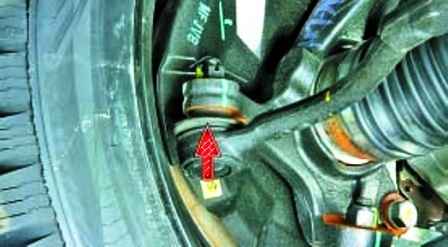
Check the condition of the protective covers of the tie rod ends.
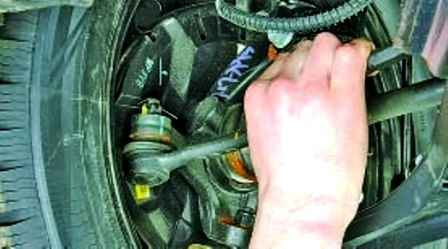
Replace any torn, cracked, or loose covers.
By turning the steering wheel sharply in both directions (this should be done by an assistant), visually and aurally check the steering gear mounting.
Movement of the mechanism and knocks are not allowed.
Prove Check for play in the ball joints of the tie rod ends.
Replace the tips, the hinges of which have a noticeable play.
Also check that the ball joint pin nuts of the tie rod ends are tight.
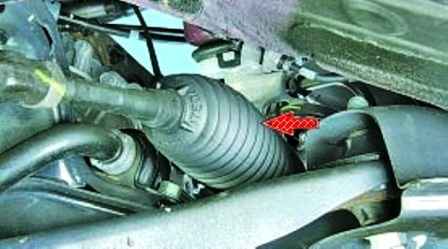
Check the condition of the protective covers of the steering rods.
Be sure to replace damaged covers.
Checking the free play of the steering wheel
This will require: a ruler, chalk, or wire for marking

Installing the front wheels in a forward-facing position

Set the ruler so that its end rests against the instrument panel, and the plane of the ruler touches the outer surface of the steering wheel rim.
Without changing the position of the ruler, turn the steering wheel to the right until the front wheels start to turn.
In this position, you need to put a mark on the steering wheel rim (or fix the wire or plastic clamp)
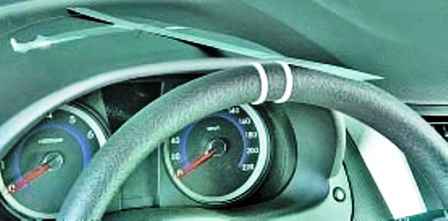
Without changing the position of the ruler, turn the steering wheel to the left until the front wheels start turning.
In this position, put a second mark on the steering wheel rim
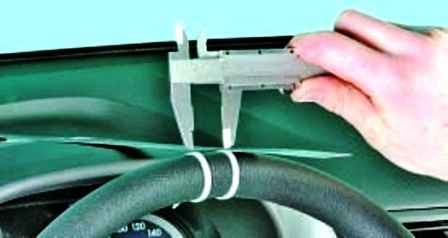
We measure the distance between the marks along the rim. It should not exceed the calculated value.
If the rudder free play is greater, the cause must be found and corrected.
The play must not exceed 5°
For a steering wheel whose outer diameter is 370 mm, the play should not exceed 15-17 mm.





